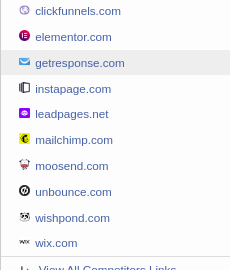As all internet marketers are aware, backlinks are the crux of the whole SEO business. These form one of the most important signals for Google when it examines your website therefore, you want to learn as much as possible about your backlink profile. This knowledge will let you acquire new opportunities as well as improve your current backlink situation.
Whether you need to find bad, spammy backlinks that you have inadvertently acquired, or find new linking possibilities, backlink analysis is the way to go. You should get into the habit of conducting this on a regular basis as doing so can greatly benefit your online presence. However, it’s not just your page that you want to analyse – you want to go after your competition as well, as that’s where the precious backlink opportunities are. There are plenty of tools that can help you with this, and some of them are even free to use, however, today, I’m going to tell you about the one I like the most – Linkody. I think it’s the easiest and most intuitive tool out there and, moreover, it provides in-depth data about yours and your competitors’ backlinks. You can get a free 30-day trial on their website.
How to conduct a backlink analysis?
Here are the main points you’ll need to cover:
Choose the websites you want to analyse

While your website is the priority here, you’ll need to look into some other ones too—namely, those of your competition. If you’ve been in the business for some time, you probably know who your competitors are. If not, there’s an easy way to find out.
Finding your competition
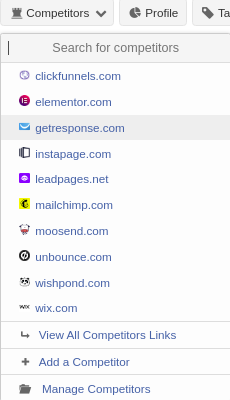
All you need to do is enter a given keyword that’s associated with your business. You may want to look for very competitive keywords, as these are what most of your rivals will be optimising for. Now, look around the SERP and find websites that fit your niche. After just a couple of Google searches, you’ll most likely get a good idea of who your competitors are.
Next, all you need to do is to click onto the Competitors tab in Linkody and add as many as you can. I’d advise that you add the ones that match your niche relatively closely and are prominent in the industry.
Number of Referring Domains
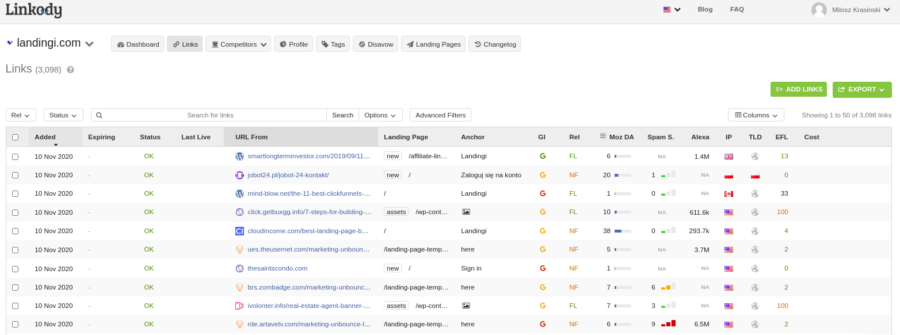
This is the number of websites that contain a link back to your page. We’re not talking about individual pages, but entire domains. Figures show that referring domains are a much better metric than the total number of links. The more links you have from a single domain, the lower their power when it comes to ranking.
You want to compare your number of referring domains to that of your competition. This is a telltale sign of how competitive the niche is and how high you stand among them.
Note how Linkody only shows you the referring domains. In fact, it’s much better to gain links from new websites than from ones you already have links from. However, if you want, you can add links from repeated domains manually.
After going through the competition, I noticed that the number of referring domains is more or less the same. This is one of the signs that the backlinks profile of this particular case is relatively good.
If you see that you have many more referring domains to your website, then it’s a signal that the links you have are spammy. You want to avoid such backlinks at all costs, as they can hurt your rankings and result in penalties by Google.
On the other hand, if the number of referring domains is much lower than your competition’s, that means you’re slacking, and you need to up your link building game a tad.
Anchors

Next up, you want to go to the Profile tab in Linkody. Here, you can see lots of useful analytical data about your link profile. What we’re interested in right now are the anchors.
From this, you can determine if your anchor profile is healthy. What you should aim for is variety and relevance. Brand keywords should be your primary target. Following the Penguin update, it’s harder than ever to rank for the more competitive keywords. Nowadays, you want to ensure diversification in your anchor texts and make sure this is as natural as possible.
We haven’t established the perfect distribution of the types of anchor texts, as it differs from niche to niche. Having said that a good rule of thumb to follow is the distribution of around 30-40% of branding texts, 30-40% of partial match anchors and 20-40% of generic, random, exact match and other types.
Domain Authority and Spam Score metrics
These metrics are hugely important in terms of the quality of your backlinks. The principle you should follow when conducting link building campaigns is quality over quantity. A link from a domain with 60 DA is much more valuable than ten links from a 15 DA domain. Sure, it takes much more time to build those high-quality links, but in the end, that’s where the juice is. Now, using Linkody, we can determine how you fare compared to your competition.

In this case, the discrepancy is quite large. You can see on the left that the distribution is not too good.
Further down, you have the Spam Score metric. You should aim to get links from websites that have as low a Spam Score as possible. Although this metric is not as decisive as DA, you can rely on it to a certain extent.

From this, you can conclude that you’ll need to focus on acquiring links from high-quality websites. Later on, I’ll tell you how to find such opportunities using Linkody.
TLD and Location
Further down, we can see the graphs for the top-level domains and the locations.

Most likely, the top TLDs will include .com in the first place. That’s good, it’s perfectly normal, as most of the websites end with .com. In this case, .pl is in the second place, as Landingi is Poland-based, so that’s pretty standard too. Now, if you see tons of links that have weird top-level domains that don’t really correspond to your business, this is where you want to take action and disavow links. Same goes for the geolocation.
Disavow rules
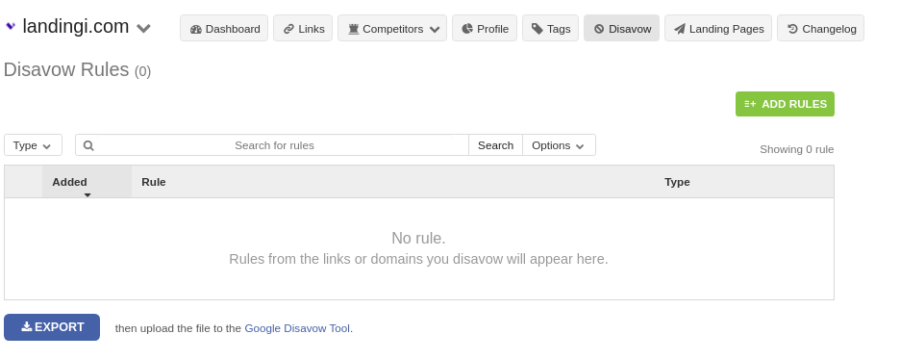
If you find some unhealthy, spammy links from shady domains, you can create rules that automatically disavow them. Using the Disavow tab, you can easily create rules and then simply export them to Google’s Disavow Tool. By doing this you can ensure that your backlinks are not violating Google’s guidelines in any way.
Manual research
Tools are immensely helpful, but you should do manual research as well. Exploring some of the websites that link back to you and checking out their relevance, topical match and authority metrics can provide you with some valuable experience and insights. After some time, you’ll be able to conclude at a glance if the link is high-enough quality or not.
Moreover, you want to know the placement of the backlink. If it’s placed somewhere in the footer or a sidebar, you should contact the editor, as it’s most likely not a valuable link at all. Try to answer the following:
- How natural/editorial does it look?
- What’s the page’s DA?
- How well does the anchor text fit?
- Is it helpful for the audience in any way?
- Is it relevant?
Gaining this experience is invaluable for link building campaigns and can help you tremendously going forward with your link building endeavours. You can look up media monitoring, too, as this is another way of looking into the mentions of your business online.
Organising all of the data
Linkody has an option to export all of your analytics into CSV files. If you want to compare lots of websites at once, it becomes necessary to use Excel or Google Sheets. It does get a little bit harder now, as you need some proficiency with data management. There are lots of guides that can help you out with this though. Here’s a great example of an Excel link analysis guide by Moz in the form of a case study.
Finding new backlink opportunities
Okay, now we’ve gotten to a point where you know how to assess your link profile but, I’ve promised you something more – new linking opportunities using the same tool. To delve into this, you’ll need to click on the Competitors tab and choose the option to see all of their backlinks at once.

You’ll be met with tens of thousands of links; (the number depends on how many competitors you’ve chosen to benchmark against).
Now, out of all those tons of backlinks, you’ll need to fish out the best opportunities. Look for websites with high DA, low Spam Score and, also, possibly the most recent acquisitions. This way, you can keep up with your competition’s pace.
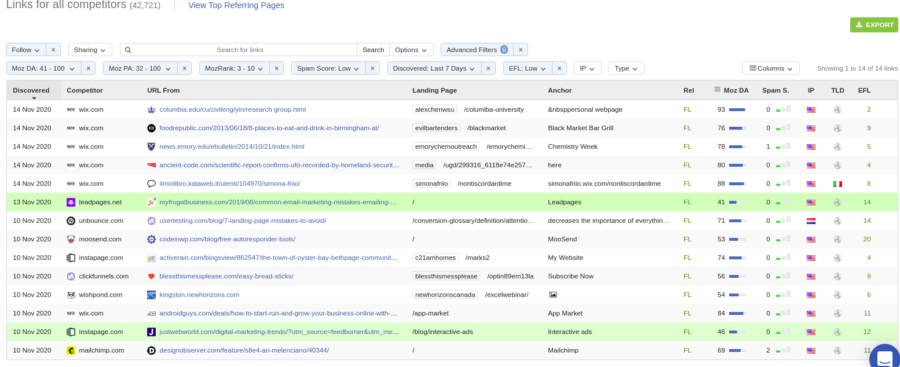
Right now, I have 42K links. How to narrow the search?
You’ll need to set the filters in a way that lets you see only the best cases.
Here are my settings, but you can go ahead and play with them. Note how I got down to just 14 links from 42K and these links are the bullseye. Now all you need to do is to reach out to the bloggers and see if they’re open for any sort of collaboration. Most likely they will be, as they just linked to your competition
Conclusion
Now you know how to conduct successful backlink profile analysis. It’s crucial to do it on a regular basis so as not to find yourself in a situation where a bad backlink profile lands you a Google penalty or hurts your rankings in other ways. It’s also a great way to find new backlink opportunities based on what your competition is doing. If you’ve not yet conducted a backlink analysis of your website, I advise you to do it quick! You’ll learn quite a bit about how your website fares among your competition. Linkody offers a 30-day free trial, so you can do it right away.
Digital & Social Articles on Business 2 Community
(30)
Report Post